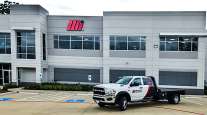Parts Makers Scramble to Meet Rising Demand
This story appears in the Feb. 28 print edition of Transport Topics.
The increase in Class 8 truck demand that began late last year has some component makers scrambling to meet the sudden surge, and one analyst warned the supply problem could get worse if orders grow as expected.
Most suppliers also raised their prices because the demand surge hit at the same time as a rapid rise in commodity prices.
“I think it’s right to call it a perfect storm, with heavy-duty truck demand going crazy, with just more and more orders being added, while at the same time the price of raw materials was shooting up, with copper, for example, quadrupling,” Jack Shaffer, president of Bergstrom Inc., Rockford, Ill., told Transport Topics.
Bergstrom produces cab air conditioners, heaters and other climate control systems for heavy duty trucks.
“Some of our suppliers in Asia were struggling last year to bring their volumes up . . . which drove us to where we were air freighting lots of components,” Patrick Cavanagh, CEO of Williams Controls Inc., Portland, Ore., told TT. “That brought a lot of heartburn, because it’s kind of expensive.”
The company manufactures electronic throttle controls for commercial vehicles.
“We saw that there were shortages of some electronic chips, so we went out to buy all we could, because we had the capital,” Cavanagh said. “They can’t build a truck without our components, so we can’t let our customers down.”
At the Technology & Maintenance Council’s annual meeting earlier this month in Tampa, Fla., several OEMs indicated that slowness in getting parts caused some build delay.
Truck dealers have heard of the delay.
“I think we’re going into a capacity component restrained situation, where Freightliner just can’t get enough parts from its suppliers, and that is what is causing the order board to run out,” Frank Ellet, president of Virginia Truck Center, a Freightliner dealership based in Roanoke, Va., told TT.
Component manufacturers said their understanding of the cyclical nature of truck building prepared them for the sudden need to increase their own production.
“The only shortages that we are aware of are related to certain electronics and raw materials shortages, which were more of a quality rejection and price issue than actual shortages,” Tim Kraus, president of the Heavy Duty Manufacturers Association, told TT.
“Difficulties might exist where there are large, unforecasted orders for trucks are placed with an OEM,” Kraus added.
Eric Starks, president of FTR Associates, Nashville, Ind., said that OEMs may face more parts shortages later in the year when demand is expected to climb to higher levels than in the first quarter.
“We’ve actually heard from some of the component guys that they are getting pressure to ramp things up more,” Starks told TT. “We believe that we will certainly start running into big component issues mid-year, but have not seen that to be a major problem, yet.”
“We had to hire back quite a few people in 2010 to meet demand and we were able to stay ahead in demand in most cases,” Gary Gerstenslager, CEO of Hendrickson, Itasca, Ill., told TT. “In a few cases, we fell behind. The increase in demand for trucks was not predicted, but overall, we did well.”
Hendrickson produces axles and truck suspensions. Gerstenslager said about 85% of the company’s products are composed of steel.
“Hot rolled steel prices rose from $520 a ton in November to $806 today,” he said. “Naturally those prices had a huge effect on our industry . . . and we had to raise our prices . . . based on a steel index price.”
Joe McAleese, CEO of Bendix Commercial Vehicle Systems, Elyria, Ohio, said his company also had to assist its suppliers, but were able to meet OEM demand.
“Our suppliers downsized as well . . . some of them may have survived the downturn but will not be able to survive the upturn, because of weak financial structure and a lack of access to financing,” McAleese told TT.
He added that once demand from the company’s original equipment manufacturers rose sharply last fall, in some instances, Bendix had to go to some to its weaker suppliers “and engage with them to keep them solvent. We’ve done what we had to do.”
“I’m not thrilled with our entire delivery performance, but we were able to keep a balance between the OEMs and the aftermarket,” McAleese said.
McAleese said that prices for the two main products that Bendix’s sub-contractors use, hot rolled steel and aluminum, “went through the roof.”
He added that the commodity increases forced “significant increases on what we buy, which we then have to recover from our customers.”
He declined to give any indication of the size of the price increases, saying they varied widely, depending on product.
No truck maker has announced any price increases related to the increased costs of components.




